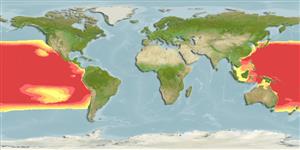>
Stomiiformes (Lightfishes and dragonfishes) >
Gonostomatidae (Bristlemouths)
Etymology: Sigmops: Taken from the name of the letter "S, sigma" (Ref. 45335).
Environment: milieu / climate zone / depth range / distribution range
Ökologie
seewasser bathypelagisch; tiefenbereich 0 - 2105 m (Ref. 58018). Deep-water
Western Pacific: Solomon Sea, Papua New Guinea, and New Zealand (Ref. 5755). Eastern Pacific: well offshore from California and Baja California (Ref. 35800).
Size / Gewicht / Alter
Maturity: Lm ? range ? - ? cm
Max length : 9.7 cm SL Männchen/unbestimmt; (Ref. 39248)
Kurzbeschreibung
Bestimmungsschlüssel | Morphologie | Morphometrie
Rückenflossenstacheln (insgesamt) : 0; Rückenflossenweichstrahlen (insgesamt) : 12 - 14; Afterflossenstacheln: 0; Afterflossenweichstrahlen: 26 - 29; Wirbelzahl: 43 - 46. Distinct from closely related species in having a much greater distance between ventral and anal fins, a correspondingly larger number of photophores in the ventral and lateral series.
Mesopelagic, primarily at about 125-300 m depth at night and 520-700 m during the day (Ref. 35800). Oviparous, with planktonic eggs and larvae (Ref. 35800). Also Ref. 58302.
Life cycle and mating behavior
Maturities | Fortpflanzung | Spawnings | Egg(s) | Fecundities | Larven
Kailola, P.J., 1987. The fishes of Papua New Guinea. A revised and annotated checklist. Vol. 1. Myxinidae to Synbranchidae. Research Bulletin No. 41. Department of Fisheries and Marine Resources, Port Moresby, Papua New Guinea. 194 p. (Ref. 6993)
IUCN Rote Liste Status (Ref. 130435)
Bedrohung für Menschen
Harmless
Nutzung durch Menschen
Tools
Zusatzinformationen
Download XML
Internet Quellen
Estimates based on models
Preferred temperature (Ref.
123201): 4.5 - 13.8, mean 7.9 °C (based on 590 cells).
Phylogenetic diversity index (Ref.
82804): PD
50 = 0.5312 [Uniqueness, from 0.5 = low to 2.0 = high].
Bayesian length-weight: a=0.00389 (0.00171 - 0.00885), b=2.99 (2.79 - 3.19), in cm total length, based on LWR estimates for this (Sub)family-body shape (Ref.
93245).
Trophic level (Ref.
69278): 3.3 ±0.4 se; based on size and trophs of closest relatives
Widerstandsfähigkeit (Ref.
120179): hoch, Verdopplung der Population dauert weniger als 15 Monate. (Preliminary K or Fecundity.).
Fishing Vulnerability (Ref.
59153): Low vulnerability (10 of 100).
